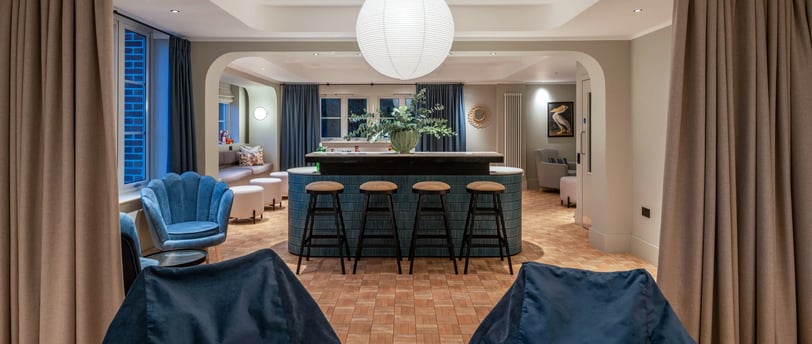Choosing the Right Finishes for Your Building Project: A Comprehensive Guide


Understanding Finishes: What Are They and Why Do They Matter?
In the context of building projects, finishes refer to the final materials and treatments applied to the surfaces within and around a structure. They play a pivotal role in determining the overall aesthetic and functionality of a space. Finishes can encompass a wide range of elements including flooring, wall treatments, ceiling designs, cabinetry, and exterior cladding. Each category of finish not only contributes to the visual appeal of a building but also affects its durability, maintenance requirements, and overall performance.
The selection of appropriate finishes is crucial for several reasons. Aesthetic appeal is often the most immediate consideration; the right finishes can help create a desired atmosphere or style within a space, be it modern, rustic, or contemporary. However, beyond visual impact, the functionality of finishes cannot be overlooked. Materials and treatment choices can significantly influence how well surfaces withstand wear, tear, and environmental factors over time.
Durability is particularly important in high-traffic areas and environments exposed to moisture, such as kitchens and bathrooms. Selecting finishes that are resistant to scratches, staining, or water damage can not only improve the longevity of the materials but can also reduce long-term maintenance costs. For example, durable floor finishes may require less frequent replacement or repair compared to less resilient options. Furthermore, easy-to-clean finishes can enhance a building's overall hygiene, making it a practical choice for both residential and commercial properties.
Ultimately, finishes are a critical aspect of any building project. A comprehensive understanding of the available options allows homeowners, architects, and builders to make informed choices that align aesthetic values with practical needs. By thoughtfully selecting the right finishes, one can harmonize beauty with performance, ensuring a successful and enduring outcome for any building endeavor.
Evaluating Your Project Needs: Style, Function, and Budget
Assessing the specific needs of a construction project is a fundamental step in ensuring its success. The evaluation process should begin with a clear understanding of the desired architectural style that aligns with the vision for the building. This could range from modern minimalism to traditional designs. The architectural style doesn’t only play a role in aesthetic appeal; it also influences the types of finishes that would be appropriate for the project. Therefore, accurately defining the style will set the groundwork for selecting compatible finishes that enhance the overall design.
In addition to style considerations, functional requirements must be thoroughly assessed. Durability and maintenance are critical aspects that should not be overlooked. For example, high-traffic areas may necessitate finishes that can withstand wear and tear, while exterior choices must combat environmental elements. It is essential to consider how different materials and finishes will perform over time to decide on options that not only meet immediate needs but also stand the test of time, contributing to the longevity of the project.
Budget constraints play a pivotal role in the decision-making process. A comprehensive budget should incorporate not only the cost of materials and labor but also consider long-term maintenance expenses associated with the chosen finishes. Prioritizing elements based on available resources will ensure that the project remains feasible while achieving aesthetic and functional goals. Evaluating these three dimensions—style, function, and budget—facilitates a balanced approach to finish selection, fostering a cohesive design that resonates with both vision and practicality. This systematic assessment ultimately leads to informed decisions that reflect the project’s aspirations and existing constraints.
Finishes for Floors: Options and Considerations
When selecting finishes for floors in your building project, several options warrant consideration, each offering distinct aesthetic qualities, durability, maintenance needs, and cost implications. Hardwood, laminate, tile, and carpet are among the most popular choices, each catering to different preferences and requirements.
Hardwood flooring is celebrated for its timeless elegance and natural beauty. Available in various wood species, it can enhance the warmth of any space. Durability is a critical advantage; however, it typically requires regular maintenance and refinishing to preserve its appearance. Additionally, hardwood tends to be one of the more costly options initially but can add significant value to a property in the long term.
Laminate flooring provides a more budget-friendly alternative that mimics the look of hardwood, tile, or stone. It is composed of synthetic materials layered for durability, making it an excellent choice for high-traffic areas. Maintenance is minimal, necessitating just regular cleaning. However, laminate may not offer the same life span as hardwood and can be susceptible to water damage, posing a consideration in moisture-prone areas.
Tile flooring is renowned for its versatility and resistance to water and stains, which makes it ideal for kitchens and bathrooms. With an array of styles, colors, and patterns available, tile can suit nearly any design aesthetic. While it is durable and easy to clean, the installation can be labor-intensive, affecting overall project costs.
Carpet remains a popular choice for its comfort and warmth, especially in residential settings. Available in myriad colors and textures, it can enhance acoustics and provide a cozy atmosphere. However, carpets require regular cleaning and may not be ideal for high-traffic zones where durability is essential.
In choosing the right finish for your floors, consider the intended use of the space, the expected foot traffic, and the overall design scheme of your building project. Each flooring option offers unique benefits that can significantly influence both aesthetics and functionality.
Wall Finishes: Paints, Wallpapers, and More
When selecting wall finishes for a building project, the decision often hinges on aesthetics, functionality, and long-term maintenance. The primary options typically include paints, wallpapers, and various types of paneling, each offering unique attributes tailored to different requirements.
Paints are one of the most versatile finishes available. They come in a wide array of colors, finishes, and textures, such as matte, satin, and glossy. The choice of paint can greatly influence the ambiance of a space. For instance, lighter colors often create an illusion of space, making rooms appear larger and more inviting. Additionally, with the evolution of eco-friendly paint options, building projects can significantly reduce their environmental impact, aligning with sustainable construction practices. However, paints can require regular maintenance; periodic touch-ups may be necessary to maintain their aesthetic appeal.
Wallpapers, on the other hand, provide an opportunity for creative expression through patterns and textures that paints cannot replicate. They offer various styles, from classic designs to contemporary motifs, allowing for strong personalization of a space. Although they can provide a more eye-catching visual effect, wallpapers require delicate handling during installation. They may also not fare well in humid environments, which could limit their use in certain areas like kitchens or bathrooms. Furthermore, removal or replacement can be more labor-intensive compared to repainting.
Paneling is another option worth considering, offering extensive durability and insulation benefits. Wood, MDF, and PVC paneling can add depth and character to a room while also providing a sound barrier. However, the choice of material is crucial; for instance, wooden panels may necessitate regular upkeep to prevent warping or damage due to moisture. When evaluating wall finishes, it's essential to balance aesthetics, functionality, and maintenance requirements to achieve the desired look and performance in your building project.
Ceiling Finishes: Elevating Your Space
When planning interior spaces, ceiling finishes often receive less attention compared to wall and floor treatments. However, the choice of ceiling finish can dramatically influence the room's acoustics, light reflection, and overall aesthetic appeal. Understanding the various options available will help you make informed decisions that enhance your building project.
One common and versatile choice is paint. A fresh coat of paint on the ceiling not only allows for a seamless color transition with the walls but also creates the opportunity to introduce new moods. Lighter shades reflect more light, making a space feel larger and airier, while darker colors can add warmth or a sense of coziness. Texture can also play a role; a matte finish can reduce glare, while a gloss finish can further amplify light reflection.
Plaster finishes, whether smooth or textured, offer durability and a timeless appeal. They can contribute to a sophisticated atmosphere and work well in both traditional and contemporary designs. One notable advantage of plaster is its ability to hide minor imperfections in the ceiling and to provide a robust surface that resists sagging over time.
Wood finishes create an inviting and warm ambiance. Beams or shiplap panels can add character and are particularly effective in rustic or farmhouse-style settings. Additionally, wood contributes to sound absorption, thus improving room acoustics, especially in larger areas where echo is a concern.
Lastly, acoustic tiles can be an excellent choice for spaces requiring enhanced sound control, such as home theaters or conference rooms. These tiles come in various styles and colors, allowing for customization without compromising on functionality. Depending on the design and purpose of the room, selecting the appropriate ceiling finish can greatly enhance the overall atmosphere, ensuring cohesion with the remaining elements of the interior design.
Outdoor Finishes: Extending Style Beyond Interiors
When it comes to outdoor construction and design, choosing the right finishes is just as crucial as selecting those for interior spaces. Outdoor finishes must balance aesthetic appeal with durability, maintaining their integrity against weather conditions while also providing functional benefits. Popular outdoor finishes include a variety of decking materials, siding options, and landscaping elements, each contributing uniquely to the property's overall style and utility.
Decking materials, such as composite, hardwood, and natural stone, offer versatility and durability. Composite materials, for instance, are designed to withstand moisture and harsh sunlight, making them a favored choice for homeowners looking for low maintenance options. In contrast, natural wood provides an organic warmth that enhances outdoor environments but may require regular sealing and treatment to prevent degradation. Understanding the advantages and disadvantages of each material is vital for making an informed decision that aligns with both style and longevity.
Siding options for outdoor walls and structures also play a significant role in completing the exterior aesthetics. Choices range from traditional wood and vinyl to more contemporary materials such as fiber cement and metal. Each option comes with its maintenance requirements and resilience against environmental factors. For instance, fiber cement offers the benefit of being fire-resistant and impervious to rot, while vinyl is known for its ease of installation and minimal upkeep.
Furthermore, landscaping elements like stone pathways, garden beds, and outdoor lighting not only enhance visual appeal but also influence the overall outdoor experience. The integration of these materials can create a seamless flow from indoors to outdoors, fortifying the connection between living spaces and nature. Therefore, when choosing outdoor finishes, it is essential to consider durability, maintenance, and design elements that complement the indoor environment, ensuring cohesive aesthetics and functionality throughout the property.
Sustainability and Future Trends in Building Finishes
As the construction industry continues to evolve, the significance of sustainability in material choices has become a focal point in selecting building finishes. A growing awareness of environmental issues has led to an increasing demand for eco-friendly materials, pushing both manufacturers and builders to innovate. Sustainable building finishes not only reduce the carbon footprint but also improve the overall health of indoor environments. Homeowners and builders alike are encouraged to invest in products that incorporate renewable resources, recycled content, and low emissions. These materials are not only environmentally responsible but often present durability benefits, ensuring that the finishes remain aesthetically pleasing for longer periods.
Another vital trend is the popularity of finishes that boast functionality and design synergy. Innovations in finishes such as permeable pavers, responsibly sourced wood, and low-VOC paints are becoming standard. Such materials contribute to enhanced air quality and environmental health. Additionally, finishes that respond to changing climates—such as heat-reflective roofing materials and insulating paint—are becoming sought-after options. By focusing on materials that reduce energy consumption or enhance energy efficiency, projects can contribute positively both to the environment and the occupants' comfort.
As we look towards the future, continued research into sustainable materials is expected to yield even more options that balance aesthetics with eco-consciousness. Builders and designers are encouraged to stay informed about the latest trends in sustainable finishes. By understanding the implications of their material selections, they can significantly influence building longevity and environmental impact. Making informed choices today not only addresses present needs but also serves to protect and preserve the environment for future generations. The intersection of sustainability and innovation in building finishes is paramount for creating spaces that reflect a commitment to ecological stewardship.


